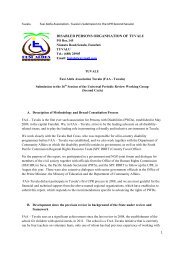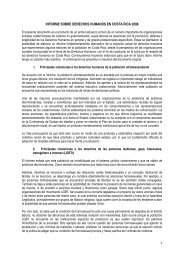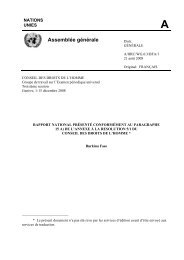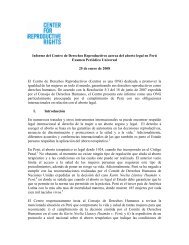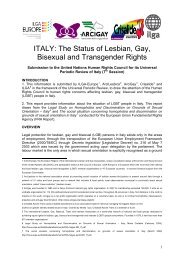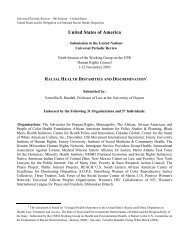Prison Needle Exchange: Lessons from a Comprehensive Review ...
Prison Needle Exchange: Lessons from a Comprehensive Review ...
Prison Needle Exchange: Lessons from a Comprehensive Review ...
Create successful ePaper yourself
Turn your PDF publications into a flip-book with our unique Google optimized e-Paper software.
lence rate of approximately 0.1% in the general population. 139<br />
There are two sources for AIDS and HIV-related data in Germany. According to the<br />
National Case Report Register for AIDS, the total number of AIDS cases diagnosed up to<br />
the end of 2001 was 21,189, approximately 75% of whom have died. Nearly 16% of AIDS<br />
cases have been diagnosed among people who inject drugs. At the end of 2001 there were<br />
2152 males living with AIDS who reported injecting drugs, 11.6% of all AIDS diagnoses<br />
among men. Among the 2620 women living with AIDS, 43.7% inject or used to inject drugs.<br />
Epidemiological data based on HIV testing is also available. Of the 18,000 laboratory tests<br />
for HIV conducted since 1993, 10.4% of the 1900 positive test results were among people<br />
who currently inject drugs or had a history of injection drug use. Women accounted for 28%<br />
of HIV-infected drug users. 140<br />
HIV/AIDS, HCV, and IDU in German prisons<br />
Several studies have estimated the HIV prevalence rate among German prisoners, with<br />
results ranging <strong>from</strong> 1.1% to 1.9%. These studies found that between 2.1% and 6.3% of prisoners<br />
who injected drugs were HIV-positive. 141<br />
Another study has indicated a link between incarceration, injection<br />
drug use, and the transmission of bloodborne diseases such as<br />
HIV and HCV. A 1993 study of over 612 people in Berlin who injected<br />
drugs concluded that the most significant factor for HIV infection<br />
among the group was sharing of needles during incarceration.<br />
Imprisonment was also found to be the second most common reason<br />
cited by the participants for needle sharing. The study concluded that<br />
a lack of access to sterile needles was counterproductive to HIV prevention<br />
measures implemented in the general community. 142<br />
Rates of HCV infection among German prisoners are higher. A<br />
1998 study in a Hamburg high-security prison for men found an<br />
HCV prevalence of 25% among all prisoners, and a 96% infection rate among people who<br />
inject drugs. A study at a women’s prison in Lower Saxony found an HCV prevalence rate<br />
of 75%, and identified 20 women who had seroconverted while incarcerated. 143 Other studies<br />
have found HCV prevalence rates of 77% among prisoners who inject drugs, and 18%<br />
for prisoners who did not inject drugs. A 2001 study of prisoners who had injected drugs<br />
only in prison found a 100% rate of HCV infection. 144<br />
History of the response to HIV/AIDS, HBV/HCV,<br />
and IDU in German prisons<br />
A 1993 study of over 612<br />
people in Berlin who injected<br />
drugs concluded that the<br />
most significant factor for<br />
HIV infection among the<br />
group was sharing of needles<br />
during incarceration.<br />
The development of the response to HIV/AIDS and hepatitis in German prisons can be<br />
described as a long process toward normalization. In the mid-1980s, when HIV/AIDS was<br />
first identified in the prison setting, there was a debate about separation, isolation of HIVpositive<br />
prisoners, and mandatory HIV testing. At this time there was also a lack of knowledge<br />
among the prison staff about transmission routes. Voluntary HIV testing is provided,<br />
although the term “voluntary” has been differently interpreted and practised <strong>from</strong> state to state.<br />
In the early years, some prisons treated all those who refused testing as HIV infected. Due to<br />
different test practices in the 16 Länder, the test rate varied <strong>from</strong> 10% to more than 90%.<br />
More than 90% of HIV- and/or HBV/HCV-positive prisoners inject drugs or have a history<br />
of injection drug use. Injecting is therefore the primary risk factor for HIV and hepatitis<br />
transmission in prisons. Despite this fact, the main response to the risks posed by injec-<br />
<strong>Review</strong> of International Evidence 25



